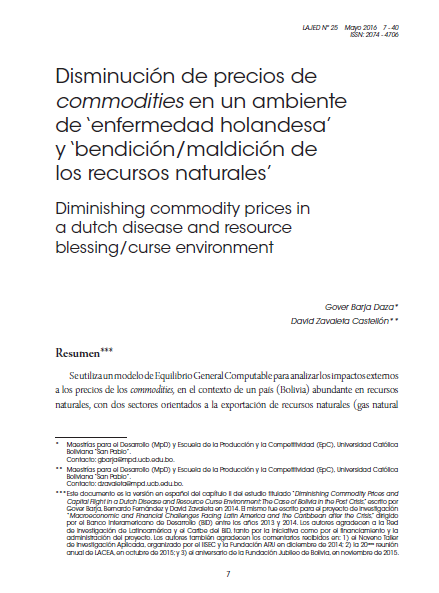Diminishing commodity prices in a dutch disease and resource blessing/curse environment.
DOI:
https://doi.org/10.35319/lajed.20162562Keywords:
Dutch disease, natural resource blessing/curse, CGE, external shocks, oil and gas, minerals, economic structure, boom/bust cycleAbstract
A Computable General Equilibrium model is used to analyze commodity price shocks in an abundant natural resource country framework (Bolivia), with two export oriented resource sectors (natural gas & oil and minerals) and mainly two emerging tradable sectors (food and manufacturing) with dominant import substitution orientation. The objective is to study how the structure of the Bolivian economy changed in a period of high international resource prices and anticipate how that economic structure should adjust in a new period of low international resource prices. Under what conditions will de boom reverse? Is Bolivia prepared?
Downloads
References
Barja, G., B.X. Fernández y D. Zavaleta. 2014. Diminishing Commodity Prices and Capital Flight in a Dutch Disease and Resource Curse Environment: The Case of Bolivia in the Post Crisis. Research Paper escrito para el proyecto Macroeconomic and Financial Challenges Facing Latin America and the Caribbean after the Crisis, administrado por el fte Latin America and Caribbean Research Network. Washington D.C.: Inter-American Development Bank.
Canavire, G., y M. Mariscal. 2010. Políticas macroeconómicas, choques externos y protección social en Bolivia. La Paz, Bolivia: Unidad de Análisis de Políticas Económicas (UDAPE).
Cerezo, S. 2014. “Testing the Hypothesis of Dutch Disease in the Bolivian Economy”. Latin American Journal of Economic Development, 21: 93-116.
Cerruti, E., y M. Mansilla. 2008. “Bolivia: The Hydrocarbons Boom and the Risk of Dutch Disease”. International Monetary Fund (IMF) Working Paper WP/08/154. Washington, D.C., United States of America: IMF.
Chakraborty, S. y E. Dabla-Norris. 2009. “The quality of public investment”. International Monetary Fund (IMF) Working Paper WP/09/154. Washington D.C., United States of America: IMF.
Clemente, L., R. Faris y A. Puente. 2002. “Natural Resource Dependence, Volatility and Economic Performance in Venezuela: The Role of a Stabilization Fund”. Andean Competitiveness Project. Cambridge, United States of America: Center for International Development.
Collier, P., R. van der Ploeg, M. Spence y A. Venables. 2010. “Managing Resource Revenues in Developing Countries”. International Monetary Fund (IMF) Staff Papers 57: 84-118.
Davis, J., R. Ossowki y A. Fedelino. 2003. Fiscal Policy Formulation and Implementation in Oil-Producing Countries. Washington, D.C., United States of America: International Monetary Fund (IMF).
Del Granado, H., L. Mokrani, M. Medinaceli y J. Gumucio. 2010. Generación, distribución y uso del excedente de hidrocarburos en Bolivia. La Paz, Bolivia: Fundación para la Investigación Estratégica en Bolivia (PIEB).
Espinoza, J. 2012. “Cooperativas mineras: el actor social emergente”. En: H. Oporto, D. Garzón, J. Espinoza y P. Portugal (editores). Los dilemas de la minería. La Paz, Bolivia: Fundación Vicente Pazos Kanki.
Frankel, J. 2010. “fte Natural Resource Curse: A Survey”. Faculty Research Working Paper Series RWP10-005. Cambridge, United States of America: Harvard Kennedy School.
Guzmán, J.C., M.C. Crespo, T. Genuzio y C. Santa Gadea. 2010. Uso productivo del excedente hidrocarburífero: propuesta de creación del Fondo Soberano de las Regiones. La Paz, Bolivia: Fundación para la Investigación Estratégica en Bolivia (PIEB).
Humphreys, M., J.D. Sachs y J.E. Stiglitz. 2007. Escaping the Resource Curse. New York, United States of America: Columbia University Press.
International Monetary Fund (IMF). 2012. “Macroeconomic Policy Framework for Resource-Rich Developing Countries”. IMF Board Paper. Washington, D.C. United States of America: IMF.
Jordán, R., J. Humérez, E. Sandi y P. Arano. 2010. Excedente y renta en la minería boliviana: determinantes del crecimiento minero 2000-2009. La Paz, Bolivia: Fundación para la Investigación Estratégica en Bolivia (PIEB).
Lederman, D. y W.F. Maloney. 2007. Natural Resources: Neither Curse nor Destiny. Washington, D.C., United States of America: fte World Bank.
Lofgren, H., R.L. Harris y S. Robinson. 2002. A Standard Computable General Equilibrium (CGE) Model in GAMS. Washington, D.C., United States of America: International Food Policy Research Institute.
Magud N. y S. Sosa. 2010. “When and Why Worry about the Real Exchange Rate Appreciation? The Missing Link Between Dutch Disease and Growth”. IMF Working Paper WP/10/271. Washington, D.C., United States of America: IMF.
Oporto, H., D. Garzón, J. Espinoza y P. Portugal. 2012. Los dilemas de la minería. La Paz, Bolivia: Fundación Pazos Kanki.
Oporto, H., J. Espinoza, R. Ferrufino, D. Garzón y H. Córdova. 2013. ¿De vuelta al Estado minero? La Paz, Bolivia: Fundación Pazos Kanki.
Reinhart, C. y K. Rogoff. 2009. This Time is Different: Eight Centuries of Financial Folly. New Jersey, United States of America: Princeton University Press.
Sachs, J.D. 2007. “How to Handle the Macroeconomics of Oil Wealth”. En: M. Humphreys, J.D. Sachs and J.E. Siglitz (editors). Escaping the Resource Curse. New York, United States of America: Columbia University Press.
Sinnot, E., J. Nash y A. De la Torre. 2010. Natural Resources in Latin America and the Caribbean: Beyond Boom and Busts? World Bank Latin American and Caribbean Studies. Washington, D.C., United States of America: The World Bank.
Torres, G., E. Gómez, J. Aliaga, J.C. Guzmán y M. Fernández. 2012. Perspectivas de la matriz energética boliviana. Instituto de Investigaciones Socio-Económicas (IISEC)- Universidad Católica Boliviana (UCB) “San Pablo” y Fundación Hanns Seidel. La Paz, Bolivia: IISEC-UCB.
Van der Ploeg, F. y A. Venables. 2013. “Absorbing a Windfall of Foreign Exchange: Dutch Disease Dynamics”. Oxcarre Research Paper 52. Oxford, United Kingdom: University of Oxford.
Warner, A. 2014. “Public investment as an engine of economic growth”. International Monetary Funf (IMF) Working Paper WP/14/148. Washington D.C., United States of America: IMF.
Zavaleta, D. 2003. “Modeling the Economic Effects of a Natural Resource Boom in General Equilibrium: fte Bolivian Case”. Ginebra, Suiza: Universidad de Ginebra.
---- 2010. “Modeling the Impact of Economic Policies on Poverty and Inequality: The Case of Bolivia”. Tesis doctoral. Ginebra, Suiza: Universidad de Ginebra.






